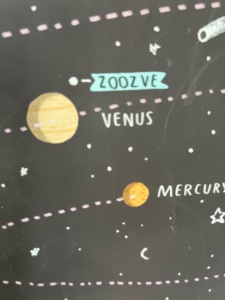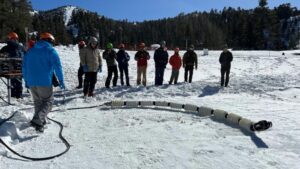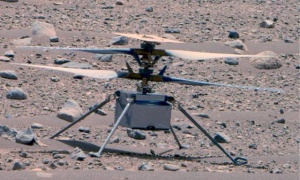
ZOOZVE ON A SOLAR SYSTEM POSTER The children’s Solar System that features Zoozve, Venus’s quasi-moon.
Image: Alex Foster / Latif Nasser (from the interweb – space.com)
Did you know that Venus has a moon? Well, sort-of, not really, but kind-of. Venus has a “quasi-moon”, something that had been predicted, but never spotted out in the universe until 2002. How quasi-moons work: they are an asteroid that stays within a planetary body’s orbit instead of fully orbiting the local star. Instead they develop a complex orbit where the planet’s and the star’s gravity fields interact.
Below – Blue is earth, Green is mercury, the center is the sun, white is Venus and the purple is 524522 Zoozve. (Source: Data source: HORIZONS System, JPL, NASA, Heavily influenced by the work of Phoenix7777 — This file is licensed under the Creative Commons Attribution-Share Alike 4.0 International license. (Wikipedia))
The quasi-moon also doubles as a near-Earth asteroid, since it crosses Earth’s path, and because of its size, “Zoozve is considered a potentially hazardous object, although it is not predicted to impact the Earth.” (Howells)
How Zoozve got its name is truly delightful. The astronomer, Brian Skiff, discovered the quasi-moon in 2002 – and the designation of “2002VE68” was applied. Later (I can’t find when, google failed me, but later than 2002 and before 2024), Alex Foster was hired to draw a Solar System poster. During research preparing for the poster trying to get the names of all the moons of the solar system, he ran across the mention of a moon for Venus and wrote 2002VE 68 in his notes. I guess his handwriting isn’t as good as his drawing – because when he went back through, he copied the name as Zoozve and put the object beside Venus marked like the other full moons had been marked.
Latif Nasser, a co-host of the science podcast Radiolab, saw the poster in his young son’s room and noticed what seemed to be an error and after confirming Venus did not have a moon with NASA because he knew a gal … and then finding out about the quasi-moon situation, he contacted Brian Skiff and proposed a name switch. The discoverer said “sure” and sent it off to the naming body for celestial objects on October 12, 2023. The International Astronomical Union (IAU) okayed the change in February 2024. (Ravisetti)
Zoozve was the first quasi-moon to be discovered. Others have been discovered and joined the category since then, including several in Earth’s plane.
Well, that ends this year’s A-to-Z blog tour. Thanks to everyone for visiting and y’all have a great year.
Bibliography
Howells, Kate. “What is Venus’ quasi-moon Zoozve?” The Planetary Society. 2024 February 12. (https://www.planetary.org/articles/venus-quasi-moon-zoozve – last viewed 5/21/2024)
Ravisetti, Monisha. “Zoozve – the strange ‘moon’ of Venus that earned its name by accident.” Space.com. 2024 February 6. (https://www.space.com/venus-quasi-moon-zoozve-radiolab-nasa – last viewed 5/21/2024)
Wikipedia. “524522 Zoozve.” (https://en.wikipedia.org/wiki/524522_Zoozve – last viewed 5/21/2024)



 Not everything can be explored with rovers and flying drones. EELS offers a third option. The drill design allows the thirteen foot long robot to cross loose soil and even go into crevasses. Things the hard-working Mars and Moon rovers get bogged down in. With the AI-decision protocols (yes, this nightmare fueled design has state-of-the-art AI built in, and not just for making art on social media), the robot can figure out how to get from here-to-there using its corkscrew apparatus. The AI will allow the explorer to operate on Saturn’s moon Enceladus and other distant surfaces without constant checking back in with ground control. Mars is bad enough with distances between four and twenty light minutes in one direction; Saturn (and her moons) start at seventy-one minutes one direction and could be as much as eighty-eight minutes depending on the Earth-Saturn relative positions in orbit around Sol.
Not everything can be explored with rovers and flying drones. EELS offers a third option. The drill design allows the thirteen foot long robot to cross loose soil and even go into crevasses. Things the hard-working Mars and Moon rovers get bogged down in. With the AI-decision protocols (yes, this nightmare fueled design has state-of-the-art AI built in, and not just for making art on social media), the robot can figure out how to get from here-to-there using its corkscrew apparatus. The AI will allow the explorer to operate on Saturn’s moon Enceladus and other distant surfaces without constant checking back in with ground control. Mars is bad enough with distances between four and twenty light minutes in one direction; Saturn (and her moons) start at seventy-one minutes one direction and could be as much as eighty-eight minutes depending on the Earth-Saturn relative positions in orbit around Sol.

